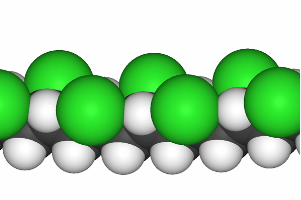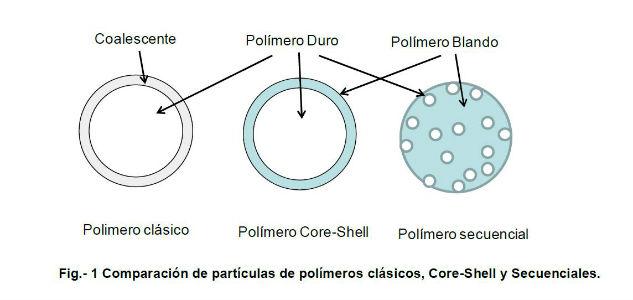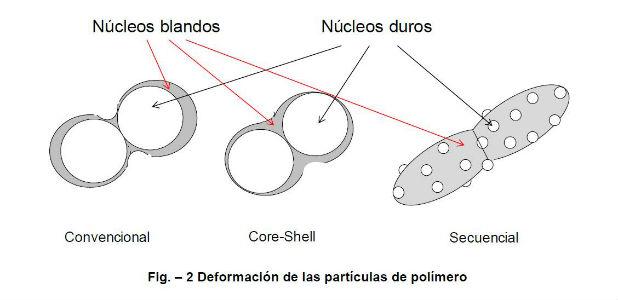 This article analyzes the pigment system, the polymers in dispersion and the relationship between the two in order to highlight obvious but not always understood particularities.
This article analyzes the pigment system, the polymers in dispersion and the relationship between the two in order to highlight obvious but not always understood particularities.
by Jordi Calvo Carbonell*
The price/quality ratio is always "the objective", even more so when the scarcity of raw materials leads to higher prices. In this situation it is necessary to carry out a value analysis that requires verifying the formulations to find the optimal point at which the client is satisfied and the costs are favorable.
About polymers
Dispersion polymers for the manufacture of paints are obtained through a process of polymerization by free radicals. These are copolymers synthesized from a mixture of hard and soft monomers, their final characteristics depend both on the relationship between monomers and on other factors such as the amount of initiator, the rate of addition of the monomers as well as the ratio of addition rates of each monomer independently.
Depending on the variables mentioned, a copolymer of quantitatively identical composition to another can vary its molecular weight, form a linear or branched polymer chain, or even vary the molecular order of the chain resulting in copolymers of completely different final characteristics.
Polymerization is carried out in a continuous medium, water, in the presence of surfactants in concentrations higher than C.C.M (Critical Micellar Concentration) which results in the formation of surfactant micelles within which the polymerization reaction occurs. By means of colloidal protectors (surfactant system, polyvinyl alcohol, cellulose esters...) a stable dispersion is obtained for commercial use. The type and quantity of these surfactants and colloidal protectors also determine the characteristics of the final product.
The dispersions of polymers that are used in the manufacture of paints and coatings usually have a Tg (Glass Transition Temperature) between -10 and 45ºC, this value can vary from the theoretical one both depending on the polymerization process and the additives used in it. Tg is the temperature above which polymers cease to have characteristics of rigidity and fragility to become plastic solids, that is, deformable.
The TMFF, Minimum Film Forming Temperature (MFFT) is the temperature above which a polymer has enough plastic characteristics to be able to deform and melt with other particles of the same polymer, in fact the scientific definition would say that it is the temperature at which the polymer chains begin to have the ability to move.
In the formulation of paints the value of tmff is widely used, even more than Tg itself, because it is the actual temperature below which the formation of a continuous film is not possible. The most widely used polymers have TMFF ranging from 0 to 35ºC. The TMFF is therefore a fundamental fact in the formulation of paints.
We therefore have two characteristics TMFF and Tg for a given polymer, the first is fundamental during the formulation process so that the paint is able to form a wet film or film capable of coalescing forming a homogeneous dry film, the second, the Tg, has its importance in the film during the coalescence process and when it has dried completely, at this time (between 14 and 21 days) the volatile components have evaporated and the surfactants have been, theoretically, expelled to the surface therefore the softening temperature is above the Tg.
The polymer dispersions most widely used for coatings have TMFF between 0 and 22ºC, being some extremely sticky and elastic while the others are hard and fragile requiring the inclusion of coalescing to reduce their TMFF to be applied. However, manufacturing methods have evolved from the addition of polymers at varying rates.
The first step of this evolution is the production of "Core-Shell" polymers that allow to form particles of hard core and soft envelope or vice versa by polymerization in the first phase of a type of copolymer and in the second, in the same miscellaneous, another of different characteristics. In the manufacture of paints they are generally used with the hard core and the soft wrap which allows, without using any type of solvent (Coalescent), to prepare the paint since the soft wrap can deform and coalesce with the adjacent particles.
A second advance in the polymerization process is the so-called "sequential" or by "inclusion" that occurs as its name indicates by varying the sequence of addition of polymers as the process progresses, the result is similar to that of core-shel polymers but with a different morphological structure, it is not about envelopes and nuclei but about discontinuities in the particle as can be seen in Fig.-1

Fig.- 1 Comparison of classical polymer particles, Core-Shell and Sequential.
How does coalescence occur?
The formation of the film or paint film using a resin in solution is easy to understand, the evaporation of the solvent increases the concentration of the solution until it forms a continuous solid.
The formation of a film or film with a binder in the form of polymer dispersion has a strong parallelism with the resins in solution, however it is part of solid particles suspended in a continuous medium that is water. By adding coalescing (polymer solvents of very slow evaporation rate) it is possible to form on the surface of the particle a more or less thick layer of solution of the same, this layer has two characteristics, on the one hand it is deformable, on the other it can melt with other particles that are in the same conditions.
The Tg of the polymer is not modified by the addition of the solvents but a solution of it is formed on the surface of the particle which allows its fusion to occur by the mere fact of being dissolved, when the solvent evaporates completely the Tg corresponds to the polymer in its pure state. What does modify the addition of coalescing is the TMFF reducing it in proportion to the amount of coalescing added and allowing the formation of the film at a temperature below the Tg.
Finally, the amount of coalescing added to a polymer dispersion has a limit in which the softening of the particles is excessive and can lead to the premature fusion of these (in the container) with the consequent formation of lumps or gumming, therefore an optimization of the same is necessary.
Next, we try to visualize graphically the types of particle from a conventional polymerization, polymerization "Core-Shell" and finally one obtained by polymerization "Sequential".
In the first case, to reduce the TMFF to a temperature suitable for its application, a certain amount of coalescing must be added, which can be between 2 and 5% calculated on polymer solids. In the case of Core-Shell and Sequential dispersions, coalescing is not required since they have been designed so that coalescence occurs above 2ºC.
In the case of classical polymerization and Core-Shell, the dispersion particles have a similar morphology, the former have a soft surface resulting from the addition of coalescing and the latter because the envelope is itself soft. In the particles obtained by sequential polymerization, depending on the design, they have a soft nucleus that may or may not be homogeneous and hard discontinuities on the surface.
It is interesting to note that while in conventional polymers one can speak of a certain TMFF and Tg, in core-shell polymers a specific TMFF and a double Tg corresponding to the core and the envelope are indicated, finally in sequential polymers the TMFF is defined while the Tg corresponds to an arc of values since the composition of the soft part is not necessarily homogeneous.
When the paint is applied, the evaporation of the water begins and the film of this begins to concentrate to the point where the polymer particles come into contact with each other, at which time their deformation and coalescence begins. The deformation, for obvious reasons, tends to pass from the initial, spherical state to the polyhedral form, it should be borne in mind that depending on the morphology the process and the result will be different.
In Fig-2 you can see how the particles obtained by the different processes come into contact depending on the pressure exerted by other particles.

Fig. – 2 Deformation of polymer particles
The result of polymer films after coalescence resemble those shown in Fig.-3.

Fig.-3 Morphology of dry film.
The film obtained from a conventional polymer is totally homogeneous, its minimum thickness is determined by the particle size. The films obtained from a core-shell polymer have the surface formed by the soft polymer phase and their thickness depends on the size of the hard core. Sequential polymers have hard particles on their surface while their thickness is ultimately determined by the size of the harder particles which leads to a greater capacity for surface extension.
* Jordi Calvo Carbonell is a Chemical Engineer and can be contacted at the email [email protected]
























Leave your comment